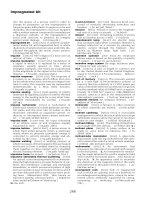Coatings Technology Handbook Episode 2 Part 3 pps
Bạn đang xem bản rút gọn của tài liệu. Xem và tải ngay bản đầy đủ của tài liệu tại đây (459.32 KB, 15 trang )
45
-4
Coatings Technology Handbook, Third Edition
45.6 What Different Types of Dispersers Are Available, and What
Type Is Best for Me?
Dispersers are available with single-speed, two-speed, and variable-speed mixing shafts. Some are directly
mounted atop a tank and are fixed to operate with the blade in only the original mounting position
(Figure 45.3). Other tank-mounted dispersers can raise and lower the blade by several feet (to better
control the vortex) without exiting the tank. Another design, perhaps the most popular, places the
disperser atop a hydraulic lift (similar to the ones used at gas stations to lift automobiles) that is mounted
to the floor (Figure 45.4). The lift enables the operator to raise the blade completely out of the mixing
vessel and change to another vessel. This technique uses small portable tanks (up to 500 gal) that can be
rolled away on wheels or picked up with a fork truck. Larger stationary tanks are often centered within
the arc of rotation from the center of the hoist to the center of the mixing shaft. The bridge containing
FIGURE 45.3
Tank mounted disperser.
FIGURE 45.4
HV-HVI disperser.
DK4036_book.fm Page 4 Monday, April 25, 2005 12:18 PM
© 2006 by Taylor & Francis Group, LLC
A Practical Guide to High-Speed Dispersion
45
-5
the mixing shaft at one end and the motor at the other is then rotated from one tank to the next. Choosing
the best configuration of available designs is a combination of functional need and economic justification.
An experienced process engineer or consultant familiar with dispersers is a good investment.
45.7 How Do I Select the Proper Size Disperser?
The size of a disperser is generally thought of in terms of horsepower. However, there are dispersers
that are dimensionally very large but use relatively small amounts of horsepower. These are exceptions
to the rule.
The horsepower of the disperser is related to the blade diameter and the anticipated load the blade
will create at a given speed and resistance. The resistance is a function of the rheology of the dispersion
as well as the viscosity and density. However, as the blade diameter increases, the horsepower increases
disproportionately. For example, if a 12 diameter blade were to draw 20 hp in a non-Newtonian system
(viscosity changes with shear), doubling the blade diameter could increase the horsepower demand by
a factor of 5. That means a 24 diameter blade of the same design, working in the same product, would
require 100 hp. The larger blade would also pump considerably more so it would lend itself to working
in a much larger (perhaps five times the volume) tank and producing a much greater amount of finished
product in the same time period.
Horsepower requirements are interrelated with blade diameter, tank diameter, batch size, rheology,
viscosity, and density. Variations outside recommended operating parameters usually result in compro-
mises in performance, such as poor particle separation, extended dispersion times, and a decrease in
quality of the finished product.
45.8 How Do I Select the Proper Size Tank for My Disperser?
The ideal tank for most dispersers is slightly taller than wide. Dished- or bowl-shaped bottoms aid in
preventing solids from accumulating in sharp corners associated with flat bottoms. Equally as important,
dished bottoms drain to the center, where a discharge valve can be installed. Flush bottom ball valves welded
into the center of the dished bottoms further enhance the ease of discharge and cleaning. Optimum tank
geometry is an integral part of several aspects that need be considered and are listed later in this chapter.
45.9 How Do I Select the Proper Size Blade for My Disperser?
The blade is sized based upon the flow characteristics of the product and the desired degree of dispersion.
The thicker the product, the larger the blade diameter must be in comparison to the tank diameter.
Conversely, the thinner the product, the smaller the blade diameter must be in comparison to the tank
diameter. This comparison is called the blade-to-tank ratio. Thick products like heavy, flowable pastes
may require a ratio of 1/2:1. Moderate products like paint require 1/3:1 ratio, and thin products like
stains can work with up to a 1/8:1 ratio.
For example, if the blade-to-tank ratio is 1/3:1, and the tank diameter is 6 ft, the blade diameter would
be 2 ft.
45.9.1 How Do I Know When It Is Time to Replace My Blade?
Once the batch formula has been process optimized, the typical time required to reach maximum
dispersion should range from 20 to 30 min after the last ingredients have been added. Longer times do
not usually result in better dispersions and, in some cases, can be detrimental because of the higher batch
temperatures generated by the high shear disperser blade. As the blade begins to wear, longer batch times
are required to get to the optimized dispersion standard. Sawtooth-type disperser blades should be
replaced once the blade tips are worn to one-half their original height.
DK4036_book.fm Page 5 Monday, April 25, 2005 12:18 PM
© 2006 by Taylor & Francis Group, LLC
45
-6
Coatings Technology Handbook, Third Edition
45.9.2 What Type of Blade Works Best on My Disperser?
High shear disperser blades are available in a range of styles and sizes (Figure 45.5). They can be generally
categorized into two groups: open sawtooth and ring type. Both categories work well when used under
the proper operating conditions.
The open sawtooth blade is the most popular because of its low cost, ease of cleaning, and general
utility. It is available in a wide range of tooth designs. As the teeth increase in size and become more
aggressive in shape, the pumping ability of the blade increases. However, as pumping (turbulent flow)
increases, shear decreases. A high pumping saw blade still generates significant shear compared to a low
shear paddle blade agitator. This aspect is an important consideration when determining exactly what is
to be achieved in the finished product.
The ring-type blade is a powerful tool for optimizing disperser performance. It is more expensive to
purchase and consumes more horsepower than the saw blade. It typically runs at higher tip speeds (5700+
fpm) and performs more like a rotor stator. Instead of solely depending upon the face of the disc and
the configuration of the sawtooth for shear and flow, much of the ring blade’s work is done hydraulically,
as centrifugal force forces the product between the contoured rings, creating velocity differentials and a
high-pressure zone within, and then instantaneously discharging into the low-pressure area outside the
rings, creating a film splitting venturi effect. Additional heat is created as a by-product of the higher
shear. However, in some cases, this higher shear level eliminates or greatly reduces any subsequent milling
that may have previously been required.
45.10 What Other Factors Affect the Performance of My
Disperser?
Formulating for a disperser is an important part of reaching optimum dispersion. Optimizing a formula
can sometimes have more to do with how and when ingredients are added, because basic recipe changes
may not be acceptable. In most instances, rapid addition of about one-half the total amount of powders
into the liquid vehicle is acceptable, although careful observation of each initial formula is prudent to
ensure that powders are not floating on top of the batch for more than a few seconds. Adding dry powders
too rapidly can “choke” the blade and may result in an incomplete, unstable dispersion. The last half of
the powders should be added progressively more slowly until the final percentage completes the formula.
The blade speed should be adjustable from a minimum of one-half the final tip speed at the beginning
of the powder addition to the maximum of the final tip speed as the batch thickness and flow slow. This
procedure helps prevent splashing and overvortexing, which are inefficient for dispersion and can cause
FIGURE 45.5
Disperser blades.
"F" style: the "Saw Tooth" blade
"E" style: the "Cutter" blade
"G" style: the
"High Vaned" blade
DK4036_book.fm Page 6 Monday, April 25, 2005 12:18 PM
© 2006 by Taylor & Francis Group, LLC
A Practical Guide to High-Speed Dispersion
45
-7
excessive air entrapment in the dispersion. Assuming the rules of tank size, horsepower, blade size, etc.,
have been followed, most dispersions are completed within 20 to 30 min after the last of the powders
have been properly added. Continuing the dispersion process beyond that time is usually unproductive
and can actually cause harm to some ingredients if the temperature continues to rise.
Typically, dispersers perform best when the flow pattern is doughnut shaped and the blade tips are
traveling at about 5000 ft/min in a medium viscosity (1500 to 5000 centipoises). Lower tip speed may
be acceptable at higher viscosities, and higher tip speeds may be acceptable at lower viscosities to get to
the same shear rate and stress. In other words, shear is a function of blade tip speed and product rheology.
45.11 How Do I Operate My Disperser for Optimum
Performance?
The following is a summary of the detailed aspects outlined in the above paragraphs. Optimum perfor-
mance requires the following criteria:
1. Start with a clean tank
2. Correct blade-to-tank ratio
3. Proper formulation
4. Suitable blade in good condition
5. Highest appropriate blade tip speed
6. Correct tank geometry (length compared to width)
7. Sufficient horsepower
8. Proper technique of adding raw materials
9. Proper rheology
45.12 What Safety Measures Must I Follow and Why?
1. Read the operation and safety instructions supplied by the manufacturer. If they are not available,
call the manufacturer and request additional copies.
2. Be certain that all operators are properly trained on the use and drilled on the potential dangers
involved with the disperser.
3. Do not operate the machine unless all the appropriate safety features are in place and are func-
tioning properly. On hoist mounted units that raise and lower the blade, these features include
but are not limited to mixing shaft guard, tank holder with limit switch, and limit switch on lift
to prevent machine from operating with blade or shaft within reach of the operator.
The disperser is a very fast and powerful machine. Serious and fatal accidents can occur in a split
second of carelessness. Human reflex is no match for the instantaneous danger of operating a disperser
unsafely. Never sacrifice safety for convenience.
DK4036_book.fm Page 7 Monday, April 25, 2005 12:18 PM
© 2006 by Taylor & Francis Group, LLC
III
-1
III
Materials
DK4036_book.fm Page 1 Monday, April 25, 2005 12:18 PM
© 2006 by Taylor & Francis Group, LLC
46
-1
46
Acrylic Polymers
46.1 Introduction
46-
1
46.2 Chemistry and Manufacture
46-
1
46.3 Versatility of Acrylics
46-
2
46.4
46.5 Coating Techniques
46-
8
46.1 Introduction
Since their introduction decades ago, acrylic polymers have gained a strong foothold in the coatings and
allied industries as a result of their improved flexibility and adhesion compared to polyvinyl acetate
emulsions, phenolics, and styrene-butadiene latex combined with their moderate cost. In addition, their
significantly improved outdoor durability, including resistance to ultraviolet degradation, has mandated
their use in several applications. In many respects, the name “acrylic” has become synonymous with a
high performance level in a polymer system.
Presently, acrylics are available in three physical forms: solid beads, solution polymers, and emulsions.
The emulsion form is by far the dominant form in use today. This is due generally to the ease of tailoring
properties, and the lower hazards and manufacturing costs compared to the solid and solution polymers.
46.2 Chemistry and Manufacture
46.2.1 Monomers
Acrylic monomers are esters of acrylic and methacrylic acid. Some common esters are methyl, ethyl,
isobutyl,
n
-butyl, 2-ethylhexyl, octyl, lauryl, and stearyl. The esters can contain functional groups such
as hydroxyl groups (e.g., hydroxyethyl methacrylate), amino groups (e.g., dimethylaminoethyl methacry-
late), amide groups (acrylamide), and so on, in addition to the carboxylic acid functionality of the
unesterified monomer. Acrylic monomers can be multifunctional (e.g., trimethylolpropane triacrylate,
or butylenes glycol diacrylate, to mention two). The polymer chemist has a wide range of monomers to
select from when designing a specialty polymer system.
Typically, mixtures of comonomers are chosen for the properties they impart to the polymer. Adhesive
strength, for example, is increased by using monomers with low glass transition temperatures such as butyl
acrylate or 2-ethyl hexylacrylate. Members of the carboxylic acid group of acrylic and methacrylic acids
also tend to increase the adhesive properties of polymers. Cohesive strength is usually imparted by the
harder acrylic monomers such as methyl methacrylate and methyl acrylate. Molecular weight is also a
significant contributing factor, and these two parameters must be carefully balanced by the polymer chemist.
Ronald A. Lombardi
ICI Resins US
James D. Gasper
ICI Resins US
DK4036_book.fm Page 1 Monday, April 25, 2005 12:18 PM
© 2006 by Taylor & Francis Group, LLC
Monomers • Polymerization Methods
Coatings • Adhesives • Inks
Glass Transition Temperature • Emulsion Acrylics
Gravure Coaters • Flexographic Coaters • Wire-Wound Rod
Application Areas 46-4
Coaters • Knife over Roll Coaters • Reverse Roll Coaters
46
-6
Coatings Technology Handbook, Third Edition
46.4.2.1 Heat-Sealable Adhesives
Heat sealing is used for bonding two substrates where one or both are impervious to water. Typically,
the more heat- and solvent-resistant substrate is coated first, and the solvent or water is driven off in an
oven. At this point, the web can be wound up on itself (if the dried adhesive is tack free or nonblocking)
and heat sealed to the secondary substrate at a later date. Alternatively, the adhesive-coated substrate can
be laminated simultaneously to the second substrate to form the finished product. The latter case is the
laminating adhesive technique, discussed later. When heat is applied to activate or soften the adhesive,
two conditions must be met for adequate bonding:
1. The adhesive must have sufficient flow at the activation temperature to properly wet out the
secondary substrate.
2. The adhesive must have a chemical affinity or specific adhesion to the particular substrate. This
comprises the secondary chemical bonding forces, which give rise to what we call adhesive bonding.
Many applications involving food packaging fall into this category. Examples include lidding-type
adhesives for coffee creamers and jams and the blister packaging of pharmaceuticals.
46.4.2.2 Laminating Adhesives
Laminating adhesives function much the same as heat-seal adhesives except that the temperature neces-
sary to activate the adhesive is much lower. Where heat-seal adhesives may require an activation tem-
perature of 120
°
C (250
°
F), laminating adhesives can be designed to function anywhere between room
temperature and 90
°
C (200
°
F). Recently, new low temperature curing types of adhesive have, to some
degree, replaced two-component solvent-polyurethane adhesives in the flexible packaging area.
13
Design-
ing a room temperature curing mechanism into an acrylate system further enhances opportunities to
replace solvent systems.
14
Considerable progress has also been made using low temperature curing acrylics
in the industrial area.
15
Typical applications include vinyl-to-wood laminating and bonding vinyl to ABS for automotive
interiors.
46.4.2.3 Pressure-Sensitive Adhesives
The pressure-sensitive method of bonding is often called the “one-way” bonding method. The adhesive
is coated onto the substrate either directly or by transfer coating. The adhesive is protected by a release
liner until it is ready to be used. When application is desired, the liner is removed and the adhesive-
coated substrate is bonded to the other substrate using pressure alone. Pressure actually activates the
adhesive, hence the name of this method. Upon firm pressure, the tacky adhesive mass actually flows
and bonds itself both mechanically and chemically to the other surface.
However, to be functional, a pressure-sensitive adhesive must be more than just very tacky. Flypaper
has a very high degree of tack but lacks internal strength or cohesiveness. A functional pressure-sensitive
material will have high tack or adhesive strength combined with high cohesive strength, the basis require-
ment for any adhesive.
Pressure-sensitive adhesives are used in many tape areas such as packaging, masking, electrical mend-
ing, medical, and mounting. The graphic arts area includes vinyl decals and special decorative films such
as clear and metallized polyester films. These areas generally require an outstanding balance of properties
that must be retained under severe outdoor exposure and temperature extremes. Such properties as
outstanding resistance to ultraviolet light degradation and plasticizer migration are required. Adhesives
for this area must produce clear and colorless films, dictating the use of acrylics exclusively.
16
Solvent-based polystyrene acrylics (PSAs) have been traditionally used in these areas. More recently,
they have been replaced in varying degrees with their emulsion counterparts.
17
However, there still exist
technical areas in which the solvent systems prevail.
18
These include applications requiring high levels of
heat, water, and solvent resistance.
DK4036_book.fm Page 6 Monday, April 25, 2005 12:18 PM
© 2006 by Taylor & Francis Group, LLC
46
-10
Coatings Technology Handbook, Third Edition
increases coating weight, whereas slowing the applicator roll decreases coating weight. The primary reason
for using a reverse roll coater is that a precise, uniform coating weight across the web can be attained.
Dried film tolerances of ~0.0001 in. are possible. The other desirable feature is that coating weight
thickness is independent of the backing weight variation. This is exactly opposite to the relationship on
a knife over roll coater. Coating thickness in a reverse roll coater is generally a function of the following:
• Gap between applicator and metering roll
•Applicator roll speed
•Adhesive solids, viscosity, and rheology
Two primary coating supply systems are used when applying adhesives or coatings by reverse roll. For
higher viscosities (10,000 to 20,000 cp), a nip-fed arrangement is utilized. For lower viscosities (3000 to
10,000 cp), a pan-fed system is preferred.
The principal drawback to the reverse roll coater is the expense, as high precision rolls and bearings
are required. However, the initial investment is usually outweighed by the improvement in quality of the
finished product.
References
1. J. A. Brand and L. W. Morgan, U.S. Patent 4,546,160; S. C. Johnson & Son, Inc.
2. K. W. Free, U.S. Patent 3,821,330; E. I. Dupont de Nemours and Co.
3. K. Shimada et al., U.S. Patent 3,968,059; Mitsubishi Raon Co. Ltd.
4. H. F. Mark,
Encyclopedia of Polymer Science and Technology,
Vol. 5. New York: Wiley, 2003, pp.
801–859.
5. B.F. Goodrich Chemical Company, Latex Product Date, Bulletin L–12, p. 14.
6. Rohm and Haas Company, Bulletin SP197, Special Products Department.
7. B.F. Goodrich Chemical Company, Latex Bulletin L–10, p. 4.
8. B.F. Goodrich Chemical Company, Latex Bulletin L–19, p. 12.
9. R. A. Heckman,
J. Prot. Coat. Linings, 3
. 10 (1986).
10. J. E. Fitzwater, Jr.,
J. Water-Borne Coat., 8
, 3 (1985).
11. J. E. Fitzwater, Jr.,
J. Water-Borne Coat., 7
, 3 (1984).
12. G. Pollano and A. Lurier,
J. Water-Borne Coat., 9
, 1 (1986).
13. P. Foreman,
Paper Film and Foil Converter,
November 1982.
14. R. A. Lombardi,
Adhes. Age,
February 1987.
15. A. H. Bealieu and F. P. Hoenisch,
J. Water-Borne Coat., 10
, 1 (1987).
16. D. Satas,
Handbook of Pressure Sensitive Adhesive Technology,
2nd ed. New York: Van Nostrand
Reinhold, 1989.
17. R. A. Lombardi,
Higher Performance Water-Borne Pressure Sensitive Adhesives.
Pressure Sensitive
Ta pe Council Seminar, Itasca, IL, 1987.
18. F. T. Koehler and J. A. Fries,
Acrylic Emulsion PSAs: Performance vs. Acrylic Solutions.
Spring Seminar,
Adhesive and Sealant Council, Atlanta, 1985.
19. G. Sen,
Am. Ink Maker, 65, 12 (1987).
20. M. T. Nowak, Am. Ink Maker, 62, 10 (1984).
DK4036_book.fm Page 10 Monday, April 25, 2005 12:18 PM
© 2006 by Taylor & Francis Group, LLC
47
-1
47
Vinyl Ether Polymers
47.1 General
47-
1
47.2 Monomers
47-
1
47.3 Production of Polymers
47-
1
47.4 Products on the Market
47-
2
47.5 Properties
47-
2
47.6 Applications
47-
3
Bibliography
47-
3
47.1 General
The general formula for vinyl ether polymers used in the production of adhesives and coatings is as
follows.
The consistency of these polymers depends on their molar mass and ranges from viscous oils to rubbery
solids.
Vinyl ether was first converted into a resinous polymer more than a century ago. Between 1920 and
1930, it became readily accessible by the techniques of Reppe chemistry and thus attracted industrial
interest. Means were then investigated for polymerizing it. In 1938 the large-scale production of vinyl
ether polymers commenced in the Ludwigshafen works of the former IG-Farbenproduktion (now the
Carbide Corporation, which relinquished the field in 1976.
47.2 Monomers
The Reppe reaction between acetylene and an alcohol gives rise to vinyl ether:
HC
≡
CH
+
H–OR
→
CH
2
=
CH–OR
It is still the only method of producing vinyl ethers that has acquired industrial significance. The
47.3 Production of Polymers
Vinyl ethers can be easily polymerized in bulk or in solution, by batch or continuous techniques. Owing
to the considerable heat of reaction, careful control and elaborate equipment are essential. The monomers
and the initiator are metered continuously into the reactor, and the polymerization reaction sets in within
a few minutes. After the reactor has been completely charged, it is closed, and polymerization proceeds
further under pressure. The boiling point of the monomer or the solvent governs the rate at which the
Helmut W. J. Müller
BASF AG, Ludwigshafen/Rhein
DK4036_book.fm Page 1 Monday, April 25, 2005 12:18 PM
© 2006 by Taylor & Francis Group, LLC
main production site of BASF AG). GAF Corporation started production after 1940, followed by Union
properties of the constituent monomers are listed in Table 47.1.
48
-1
48
Poly(Styrene-Butadiene)
48.1 Introduction
48-
1
48.2 Emulsion Polymerization
48-
1
48.3 Characteristics of Styrene-Butadiene Latex
48-
3
48.4 Uses
48-
3
Bibliography
48-
4
48.1 Introduction
Styrene-butadiene (SB) polymers are used in coatings formulations primarily to improve coating strength,
printability, gloss, pigment and fiber binding, and substrate bond strength. The styrene-butadiene poly-
mers are produced primarily by emulsion polymerization to form a latex. A latex is a dispersion of finely
divided spherical particles of polymer in water. The monomer ratios of styrene and butadiene can be
adjusted to give the desired amount of flexibility or stiffness. Polystyrene latex contains hard polymer
particles that will not form a continuous film upon drying at room temperature. Polybutadiene latex
contains very soft, gummy polymer particles that will produce a weak, sticky film when dried. By
copolymerization of styrene and butadiene monomers and adjustment of the monomer ratios, it is
possible to obtain a copolymer with a wide range of intermediate properties. Thus, a copolymer latex
with a high styrene content will produce a very tough, durable film but will not have the flexibility and
adhesive performance of a latex with a high butadiene content.
The temperature at which the copolymer changes from a brittle to a rubbery state is known as the
g
the
T
g
of SB copolymers. As the concentration of styrene in the copolymer increases, the
T
g
also increases.
This property is important in coatings for determining durability of the dried film and optimizing
curing conditions.
A typical latex will contain 45 to 55% polymer, with the balance being water.
cross-linking, and molecular weight can all be controlled, and this is accomplished through free radical
emulsion polymerization.
48.2 Emulsion Polymerization
Emulsion polymerizations require an emulsifier or surfactant composed of a hydrophobic and a hydro-
philic portion to give the latex colloidal stability. As low levels of surfactant are added into the aqueous
solution in a reactor vessel, the surfactant will saturate the water phase, and as the concentration is
critical micelle concentration. As the styrene and butadiene monomers are added, they will diffuse
through the water phase and into the micelles until an equilibrium is obtained. The majority of poly-
Randall W. Zempel
Dow Chemical Company
DK4036_book.fm Page 1 Monday, April 25, 2005 12:18 PM
© 2006 by Taylor & Francis Group, LLC
Ta ble 48.1 illustrates the typical properties of a styrene-butadiene latex. The particle size, composition,
glass transition temperature (T ). Figure 48.1 illustrates the effect of the concentration of styrene on
increased, the surfactant molecules will aggregate to form micelles. This concentration is known as the
merization occurs within these monomer-swollen micelles. Figure 48.2 is a representation of the process.
49
-1
49
Liquid Polymers
for Coatings
49.1 Introduction
49-
1
49.2 Fluid Properties
49-
1
49.3 Commercial Liquid Polymers
49-
1
49.4 Applications
49-
3
49.5 Conclusions
49-
5
References
49-
5
49.1 Introduction
High solids coatings are an alternative to solvent-borne coatings because of the coating industry’s concerns
for energy costs and the environmental impact associated with solvents. The use of 100% solids coatings,
wherein a polymer binder precursor has functional groups, was accepted by the industry.
Synthesis techniques and monomers used control the binder properties through the influence on type
and concentration of functional groups, chain configuration, and synthesis by-products. The impact on
functionality is emphasized in several reviews.
1–3
The effect on fluid properties is also discussed. One
paper on current commercial polymers includes recommended cure and uses.
2
49.2 Fluid Properties
Liquid polymers, to be useful, must be capable of blending with additives, such as pigments, curatives,
and stabilizers. Berry and Morrell discuss some of these variables in connection with liquid rubber.
4
The
factors that control this intermixing capability contribute to the viscosity of the coating system. These
factors include the following:
•Interchain entanglement — a function of molecular weight
•The glass transition temperature of the polymer
•Inter- or intrachain interactions (e.g., hydrogen bonding)
Hydrogen bonding is important in many aspects of the flow and mixing of telechelic (end group
functional) polymers and has been discussed by many authors.
5–11
49.3 Commercial Liquid Polymers
The commercial liquid addition polymers fall into several categories. Some of these products are listed
electron beam (EB) coating systems.
Robert D. Athey, Jr.
Athey Technologies
DK4036_book.fm Page 1 Monday, April 25, 2005 12:18 PM
© 2006 by Taylor & Francis Group, LLC
Polymers with Random Functionality • Telechelic Polymers •
Curing
in Table 49.1. Among the materials shown are some oligomers for incorporation into ultraviolet or
49
-4
Coatings Technology Handbook, Third Edition
Not all the liquid polymer coatings are based on telechelic functionality. Gray
29
described a randomly
functional hydroxyacrylic oligomer synthesis for use in melamine resin cured coatings. Hamann and
coworkers
30
devised a coating composed from a phenolic adduct to a liquid polybutadiene. The liquid
poly(1,2-butadienes) used in metal coating have already been noted. However, these liquid polymers are
not capable of chain extension.
Vaughn
31
devised metal or textile coating polymers having terminal carboxyl groups. There are ther-
mosetting acrylic powder coatings containing telechelic functionality.
32
The Ford Motor Company
33
devised a powder coating based on carboxylated telechelic polymer and an epoxy curative.
The acrylic–methacrylic end-capped oligomers are viscous liquids used in the radiation-cured higher
Morris
34
compared several acrylated oligomers in wood finishing applications, testing for adhesion and
abrasion resistance to choose the optimum oligomers. Christmas
35
compared monomer-diluted, radia-
tion-curable oligomers on a variety of metal substrates to obtain formulations optimized for impact
resistance, adhesion, and flexibility in a “T” bend test.
Siebert et al.
36
used carboxylated telechelic polybutadienes to toughen epoxy coatings. Jones and
coworkers
37
devised on epoxy coating cured by a mercaptan-terminated polymer. McPherson and
Gillham
38
characterized epoxy resin coatings cured by carboxylated telechelic polybutadiene by torsional
pendulum analysis, noting effects of molecular weight and compatibility of the components. Drake et
al.
39
reviewed elastomer-modifier, epoxy-based coatings.
A steel coating was devised from a hydroxy telechelic poly(styrene–butadiene) and polyisocyanate
curative.
40
A solventless coating capable of air curing was composed of an acryloyl-terminal polymer, a
product of an acryloyl chloride esterification of a hydroxylated telechelic polymer.
41
Acetylene-terminated polyphenylenes were reported as coatings by French.
42
McDonald
43
used a meth-
acrylate-terminated epoxy resin in a radiation-cured coating. Pechiney St. Gobain
44
devised a coating
based on styrene (or other monomers) and a maleic-terminated unsaturated polyester. Vranken and
Dufour
45
increased the number of electron beam cross-linking sites in low molecular weight polymers
by converting mercaptoethanol chain transfer termini to acryloyl esters on acrylic polymers.
TA BLE 49.2
Te lechelic Polymer Cure Systems
Curative Telechelic Species Ref.
Peroxide Polybutadiene diol–urethane end-capped reacted with unsaturated glycidyl
ester
55
Polymerizable oligomer Carboxylated telechelic rubber 56
Polyisocyanates Polyisoprene, polybutadiene, polystyrene diols 57
Te tramethyldiamine Halogenated telechelic polybutadiene 58
Diisocyanates Hydroxylated telechelic polybutadiene 59, 60
Hexachloro
p
–xylylene Carboxylated telechelic polybutadiene 61
Epoxy
+
tert
-amine Carboxylated telechelic polybutadiene of poly(acrylonitrile–co-butadiene) 62
Rubber Peroxyl-terminal liquid rubbers 63
4, 4
′
–Diaminodiphenylmethane Isocyanate-terminated liquid polymer 22
Epoxy
+
tert
-amine Carboxylated telechelic polyisobutyline 64
Diamines Brominated telechelic polybutadienes 65
Rubber
+
diisocyanates Hydroxylated telechelic polybutadienes or poly(propylene oxide) 66
Chlorinated elastomer Amineated telechelic polystyrene 67
tert
-Polyamines Halogenated telechelic polybutadiene 68
Iron Carboxylated telechelic polybutadiene 69
Urethane Isocyanate end-capped diols 70
tert
-Amines Mercapto ester capped liquid polymer 71
Mercaptan-terminated polymer Liquid polymer with terminal unsaturation 72
Metal oxides Carboxylated telechelic polychloroprene 73
Amine
+
iron Mercaptan-terminated butadiene copolymer 74
Organotin and organotitanate Hydroxy-terminated polysiloxane 75
DK4036_book.fm Page 4 Monday, April 25, 2005 12:18 PM
© 2006 by Taylor & Francis Group, LLC
solids formulations. The lower portion of Table 49.1 shows some commercial varieties of such products.
49
-6
Coatings Technology Handbook, Third Edition
27. Thiokol Chemical Corp., British Patent 2,325,561.
28. C. H. Sheppard and R. J. Jones, U.S. Patent 3,931,354.
29. R. A. Gray,
J. Coat. Technol.,
57
(728), 83 (September 1985).
30. K. Hamann et al., U.S. Patent 3,770,688.
31. W. L. Vaughn, U.S. Patent 3,803,087.
32. Union Chemique Belgique, British Patent 1,441,814.
33. Ford Motor Co., British Patent 1,424,968.
34. W. J. Morris,
J. Coat. Technol.,
56
(715), 49 (August 1984).
35. B. K. Christmas, Mod. Paint Coat., 152 (October 1984).
36. A. R. Siebert et al. ACS Org. Coat. Plast. Chem. Div. Prepr. 34(91), 759 (1974).
37. F. B. Jones et al., U.S. Patent 3,803,089.
38. C. A. McPherson and J. K. Gillham, ACS Org. Coat. Plast. Chem. Div. Prepr., 38(1), 229 (1978).
39. R. S. Drake et al., Epoxy Resin Chemistry II. ACS Symposium Series No. 221, 1. Washington, DC:
American Chemical Society, 1983.
40. DeSoto Inc., U.S. Patent 3,933,760.
41. Mitsubishi Gas Chem. Ind., German Patent 2,533,846.
42. J. E. French, ACS Org. Coat. Plast. Chem. Div. Prepr., 35(2), 72(1975).
43. W. H. McDonald, U.S. Patent 4,091,050.
44. Pechiney St. Gobain. German Patent 2,052,961.
45. A. Vranken and P. Dufour, German Patent 2,450,621.
46. K. Ko et al., German Patent 2,533,846.
47. J. M. Moisson-Frankhauser et al., British Patent 1,361,547.
48. Nippon Zeon Co. Ltd., Japanese Patent 49,052,851.
49. Bristol-Myers Co., Belgian Patent 49,052,851.
50. Electrochem. Ind. Co. Ltd. Japanese Patent 74,037,410.
51. J. M. Moisson-Frankhauser et al., German Patent 2,305,912.
52. Atlantic Richfield Co., British Patent 1,358,234.
53. C. C. Anderson and R. Dowbenko, U.S. Patent 4,016,332.
54. Union Chemique Belgique, German Patent 2,450,621.
55. Matsushita Electrical Works, U.S. Patent 3,957,903.
56. E. V. Khabarova et al., Kauchuk Rezina, (3), 45 (1976).
57. C. Pinazzi et al., Makromol. Chem., 1Z5, 705 (1974).
58. D. C. Edwards, ACS Polym. Div. Prepr., 15(2), 56 (1974).
59. G. L. Staton et al., ACS Polym. Div. Prepr., 15(2), 52 (1974).
60. L. M. Sergeyev et al., Polym. Sci. USSR, 12, 2339 (1970).
61. Z. N. Nudelman et al., Int. Polym. Sci. Technol., 1(4), T/27 (1974).
62. A. E. Kalaus et al., Int. Polym. Sci. Technol., 2(2), T/60 (1975).
63. N. M. Kuzmina and L. S. Chuko, Int. Polym. Sci. Technol., 1(10), A/12 (1974).
64. V. F. Antipova et al., Kauchuk Rezina, (1), 20 (1975).
65. Z. P. Chiruikova et al., Kauchuk Rezina, (12), 5 (1975).
66. L. M. Tunkel et al., Kauchuk Rezina, (3), 8 (1974).
67. H. Okamoto et al., Nippon Gomu Kyokaishi, 49(6), 520 (1976).
68. B. N. Pronin et al., Vysokomol. Soed. A, 19(3)5, 455 (1977).
69. M. Roux-Michollet et al., ACS Polym. Div. Prepr., 19(2), 369 (1978).
70. A. H. Frazer and E. J. Goldberg, U.S. Patent 2,888,440.
71. Phillips Petroleum Co., U.S. Patent 3,860,566.
72. Product Research Chemical Corp., Belgian Patent 821,959.
73. K. Marabushi, U.S. Patent 4,205,150.
74. R. W. Ireland and D. E. Skillicom, U.S. Patent 3,607,845.
75. P. A. E. Guinet and R. P. Puthet, U.S. Patent 3,409,573.
76. E. J. Goethals, Ed., Telechelic Polymers: Synthesis and Applications. Boca Raton, FL: CRC Press, 1988.
DK4036_book.fm Page 6 Monday, April 25, 2005 12:18 PM
© 2006 by Taylor & Francis Group, LLC
50
-1
50
Polyesters
50.1 Introduction and Scope
50-
1
50.2 Classification of Saturated Polyesters
50-
2
50.3 Manufacturing Processes
50-
3
50.4 Properties of Polyesters
50-
4
50.5
50.6 Preparation of Polyester Coatings
50-
7
50.7 Properties and Applications of Polyester Coatings
50-
9
References
50-
12
50.1 Introduction and Scope
Polyesters are polymers containing the recurring ester unit ~ COO ~. They are formed by a condensation
reaction between carboxyl- and hydroxyl-containing compounds. Historically, the first polyesters were
condensation products of glycerol and phthalic anhydride. Those resins were used in the paint industry
as early as 1910, but they were of low molecular weight and brittle. Later on, that is by 1925, they were
modified by the inclusion of monofunctional fatty acids, which compensated the third functional group
of the glycerol and elastified the resins. If unsaturated fatty acids were used, they rendered the resulting
resins cross-linked by air oxidation. All these resins are now generally referred to as “alkyd resins”; they
During the second half of this century, a large number of di- and trifunctional acids and glycols became
commercially available, thus creating new possibilities for the synthesis of polyesters. It was the commer-
cialization of terephthalic acid — or rather the dimethyl ester — that spurred the development of
polyethylene terephthalate, which today plays an important role for the manufacture of fibers and films,
and as an engineering plastic. In contrast to this polymer, however, which is made up of one pair of
reactants only and is, therefore, frequently referred to as homopolyester, it is the combination of more
than two reactants that yields copolyesters. For the manufacture of copolyesters, the chemist can today
draw from a large selection of monomers. This makes copolyesters a class of polymers that can be varied
over a very wide range:
•Low or high molecular weight
•Saturated or unsaturated
H. F. Huber
Hüls Troisdorf AG
D. Stoye
Hüls Troisdorf AG
DK4036_book.fm Page 1 Monday, April 25, 2005 12:18 PM
© 2006 by Taylor & Francis Group, LLC
Reaction Components • Technical Manufacturing Processes
Morphology • Solubility • Molecular Weight Distribution •
Compatibility of Polyesters • Chemical Properties
Solvent-Borne Polyester Coating • High Solids Paints •
Functionality and Reactivity • Transition Temperatures •
Waterborne Paints • Solvent-Free Coatings
Sheet and Coil Coatings • Can Coating • Automotive Paints •
Radiation-Curable Coatings • Adhesives
Analytical Procedures 50-7
Industrial Paints • Two-Component Paints • Powder Coating •
are treated in Chapter 51.









